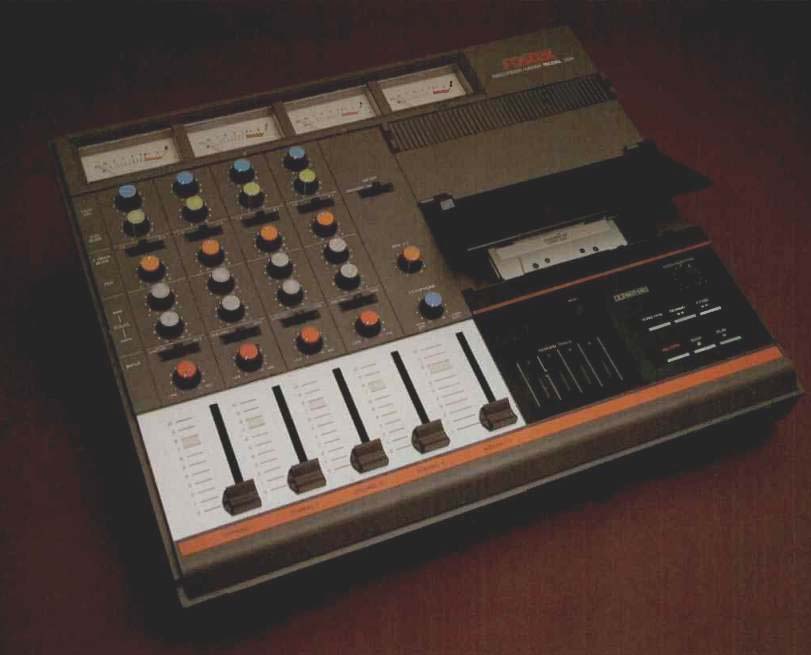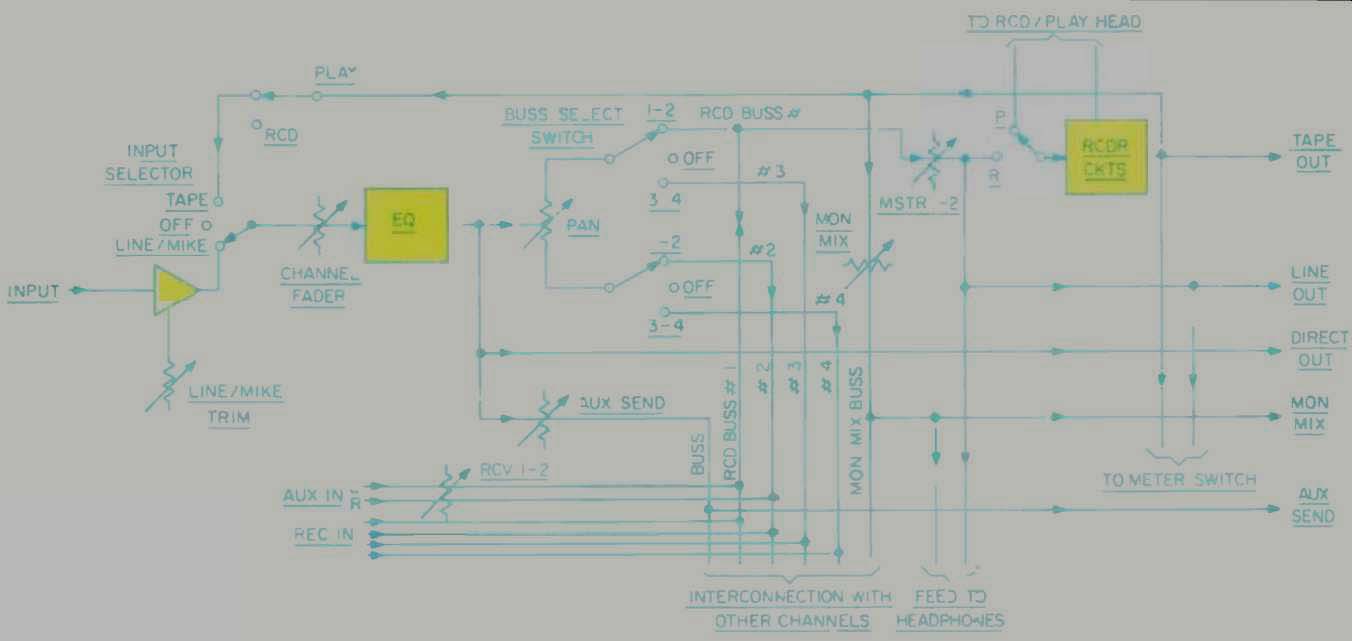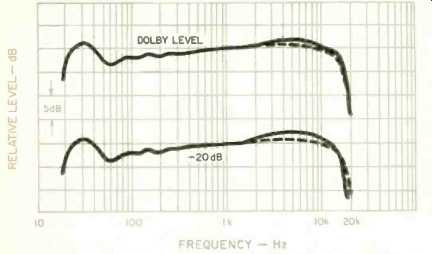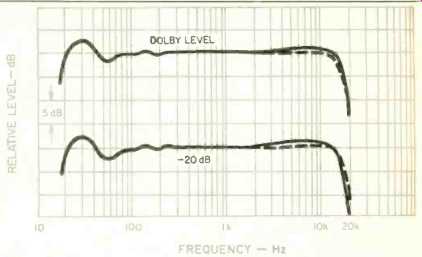
Manufacturer's Specifications:
Mixer Section:
Frequency Response: 20 Hz to 23 kHz.
Distortion: 0.05%.
S/N Ratio: 65 dBA with one mike in, 75 dBA with one line in.
Crosstalk: -65 dB.
Input Impedance: Mike/line, 50 kilohms; rec in, 20 kilohms; AUX in, 20 kilohms.
Input Level: Mike/line, 1 mV/0.3 V; rec, 0.3 V; AUX in, 0.3 V.
Output Levels: 0.3 V nominal, 5.6 V maximum.
Equalizer: ±12 dB at 4 kHz, peaking, and 300 Hz, shelving.
Recorder Section:
Format: Special 4-track cassette.
Speed: 3 3/4 ips.
Frequency Response: 20 Hz to 18 kHz.
Distortion: 1.5%. S/N Ratio: 75 dBA with Dolby C NR.
Crosstalk:-50 dB. Erasure: 70 dB.
Pitch Control: Wind Time: 80 seconds for C-60.
Tape Type: Type II (high bias and 70 uS EQ).
General Specifications
Dimensions: 17 in. (430 mm) W x 3 1/8 in. (80 mm) H x 14 in. (355 mm) D. Weight: 19 lbs. (8.5 kg).
Price: $1,300.00.
The Fostex Model 250 recorder/mixer is one of a new breed of units which combines a four-channel mixer and a four-track cassette recorder. Because it operates at 3 3/4 ips in one direction only, the recorder is definitely nonstandard, but it can do many things that a regular cassette deck cannot. This is especially so when the recorder is used in conjunction with the mixer which has considerable facility for routing and combining signals. A look at the top panel of the Model 250 immediately conveys some of the complexity involved and indicates the possibilities for musicians, band soundmen and others. Basically, there are four sets of knobs, controls, switches and jacks-each set associated with one channel. Further description of the panel features will be most easily understood with reference to Fig. 1.
The input phone jacks are on the front apron, as are two parallel headphone jacks. The signal initially feeds an amplifier with a "Line/Mic" trimming pot (CCW for line level, more CW for lower levels) and then through the input selector switch to the slide-type channel fader. The fader is closest to the front edge, with the trimmer just behind it, the best location. The lever-type input switch has positions for "Tape" (for mixdown and track bouncing), "Off" and "Line/ Mic." The next set of controls for the signal are two equalizer controls with a range of ±12 dB. The 300-Hz filter is a shelving type which is good for controlling a range of bass frequencies. The 4-kHz filter is a peaking type of moderate Q and is easily used for controlling the general brightness or presence of an input.
After the EQ section, the signal splits three ways: The pan pot, "Direct Out," and "Aux Send." There are two outputs from the pan pot. When it is at the center of its rotation the signal is fed equally to two record busses. When it is all the way CCW, the signal is fed only to the lower numbered buss (1 or 3), and when completely CW, the signal feeds only to the higher numbered buss (2 or 4). The buss select switch immediately behind the pan pot offers the choice of feeding busses 1 and 2, or 3 and 4, or none. Note in Fig. 1 that although the switch position designation is "1-2," the upper arm feeds only record buss 1, the lower arm only record buss 2. All of the record busses are tied to all channel inputs in the same manner. Record buss 1 also connects to the slide-type "Master 1-2" fader. From that point, the signal goes to the line output and the recorder circuits, if the system is in record mode. In similar fashion, the other three record busses connect to the remaining recorder tracks. There is no master fader for channels 3 and 4, however, as there is relatively little need for it. There are no line output jacks for these channels, only direct-out jacks.

Fig. 1--Simplified block diagram of one channel, Fostex 250 mixer/ recorder.
Also at the output from the EQ section is a connection to the "Direct Out" jack for feeding to another recorder, insertion of external processing, etc. Behind the buss selector lever-type switch are the "Aux Send" and "Mon Mix" rotary pots. The "Aux Send" buss combines the inputs from the four channels, and it is available at the "Aux Send" jack for external processing, such as adding reverberation. The "Mon Mix" pot and buss perform a similar function with the signal from the recorder-playback when in play mode, and the signal being recorded when in record mode.
"Aux In" jacks feed in a line-level signal into record busses 1 and 2, with the level controlled through the "RCV 1-2" pot. "Rec In" jacks provide entry into the record busses without passing through any on-board circuitry. Each channel's record buss (line out) and each tape output have connections to the meter switch which selects "Recorder" or "Mixer" levels for indication. Additionally, there are "Mon Mix" and line feeds to the headphone volume control: CW for stereo four-channel (1+3 and 2+4), CCW for the monaural mix, and in the center decent for off. All of the rotary control knobs have colored caps, which look nice and also help minimize operating errors. The designations are white on a medium-tone background, legible in fairly dim light.
The four meters at the back of the panel have good illumination, and the good-size scales are very clearly printed. They are VU-type with an overload LED next to the "5" on each meter. The cassette well's lift-up cover keeps dust out of the horizontal transport, and a cassette inserts easily.
A strip over the head assembly snaps out, giving excellent access for maintenance.
The tape counter has four LED digits of good brightness, counting below "9999" after rewind past zero. A pitch control offers a range of ±10%, and it is effective in either record or play mode. Varying speed for a certain effect in recording can be useful, but I would have preferred some status indicator to warn of possible inadvertent off-speed recording. There are record-preset buttons for each track, and a red indicator flashes for any one that is readied for recording. When "Record" is pushed, its indicator flashes as well. When "Play" is also pushed, recording starts and all indicators are steady. Flying-start recording can be initiated from any mode, as long as "Record" and "Play" are both held. The Fostex 250 has the normal wind buttons but also has one labeled "Zero Rtn," which automatically stops rewind at "0000." On the back skirt of the recorder/mixer is a collection of phono jacks: Four sets of "Rec In," "Direct Out" and "Tape Out"; the two "Aux In" jacks; the two "Line Out" jacks, and the "Mon Mix" and "Aux Send" jacks. The designations are molded plastic which are hard to read. There is also a phone jack for punch-in/punch-out recording for external control of recording by contact closure, such as with a foot switch. The power on/off switch is also on the back, but it is easily felt without looking. There is more of a question on the location of the Dolby C NR switch; it is on the bottom of the unit, near the left edge at the back. With practice most users will remember which direction of slide obtains NR, but a topside indicator might prevent some errors.
Taking off the bottom cover of the mixer/recorder was done cautiously to make certain only the correct screws were loosened. The soldering on the several p.c. boards was quite good, with a little flux residue in evidence. Part numbers on both sides of the cards were visible and interconnections were made with multi-pin cabling. There was a rigid metal frame for the drive assembly with a good-sized flywheel. The power transformer was shielded, and there were three fuses in clips.
Measurements
The first tests run on the Fostex 250 were restricted to the mixer section. The input impedances at 1 kHz and lower were 68 kilohms for the mike/line inputs, 22 kilohms for "Rec In" and 20 kilohms for "Aux In." There were lower figures with increasing frequency, but all results were satisfactorily high even at 20 kHz. With the same signal (1 kHz) fed to all channels, all meters were within a dB with all slide faders at the nominal 7.5 setting. The sensitivities for this condition were 1.0 mV for mike and 0.3 V for line. The minimum input level for zero indication was 0.48 mV, and the input overload point was 4.0 V. With the same signal to all "Rec In" jacks, meter indications matched within 0.4 dB, with zero obtained at 0.3 V. The maximum input level was 1.45 V in record mode. This was less than the specified 2.5 V, but the level was equivalent to +15 dB on the meters. There was also a close match between channels with "Aux In," with zero indications at 0.28 V input. The maximum input level was 5.5 V with the "RCV" pot at maximum, but greater than 20 V with the pot turned down. The line, "Aux Send," "Mon Mix," and direct outputs all had maximum output levels of 5.0 to 6.0 V, with clipping at a level equivalent to +25 on the meters.

Fig. 2--Frequency responses with TDK SA-X tape with and without (---) adjustment.
Dolby C NR, before EQ

Fig. 3--Frequency responses with TDK SA-X tape with and without (---) Dolby
C NR, after EQ adjustment.
The maximum level at "Tape Out" was about 1.3 V, equivalent to +13.5 dB on the meter. All output impedances were satisfactorily low for all purposes: 482 ohms for line and "Mon Mix" outputs, and 94 ohms for direct and tape outputs, with "Aux Send" even lower than that. The headphone output was 300 mW (1.7 V) with an 8-ohm load, which could be set for any level.
The peak of the 4-kHz filter was at 4.2 kHz, plenty close enough to the nominal specification. The maximum boosts were consistent from channel to channel with an average of +13.5 dB. There was a little more variation from channel to channel and less control in cut with an average of-10.9 dB, still sufficient for normal purposes. The 300-Hz shelving filter was checked for effect at 200 Hz. At that frequency, the average boost was +10.7 dB and the average cut was 9.2 dB. The effect of EQ adjustments was apparent with relatively small rotations f the knobs, so precise zero setting was required for frequency response tests. The response from line in to line out was within 1 dB from 19 Hz to 42.5 kHz, with the -3 dB points at 5.6 Hz and 74.9 kHz.
The meter responses were 3 dB down at 25 Hz and 84.9 kHz, actually higher than need be.
The harmonic distortion at nominal level was 0.023% or less from 100 Hz to over 20 kHz, rising to about 0.08% at 20 Hz. There was no increase in distortion with increasing level until the approach of clipping. The signal-to-noise ratios were 66 dBA with one mike in and 84 dBA with one line in.
The crosstalk from one channel to any other channel was 73 dB at 1 kHz, quite good and really necessary for best use of the unit. The meters showed a slightly faster response than standard VU meters, reaching zero with a 220mS burst, overshooting about a dB with the 300-mS burst.
The CW threshold of the peak indicators was +6.5 dB re meter zero on the average. They required a burst of 55 mS for a slight flicker, 75 mS for a bright turn-on. The meter scale calibrations were very close, particularly from-10 to zero.
Next, I focused on the recorder section. Meter indications with playback of a Dolby-level tape were about +2 dB, but there were no marks on the meters to show Dolby reference level. Play speed was about 1.5% fast, on the high side.
Checks of record/playback responses with a pink-noise source and an RTA display showed that a number of premium Type II tapes gave basically good results. TDK SA-X was selected for the detailed tests to follow.
The EQ pots were set for zero indication, and swept-frequency responses were made at Dolby level and 20 dB below that, both with and without Dolby C NR. Figure 2 shows the somewhat disappointing results with a droop around 100 Hz and an undesirable boost around 5 kHz. A careful check of the responses of all channels showed that the area of discrepancies corresponded to the frequency ranges of the EQ filters. Slight mechanical offsets secured much flatter responses as shown in Fig. 3. The-3 dB points were at 18 Hz on the low end and very close to 16 kHz at the high end, in all cases. The responses were very flat between 80 Hz and 13 kHz, with the exception of a slight boost with Dolby NR; the head bumps are rather obvious, with the dip around 60 Hz, and the boost at 30 Hz.
The phase jitter in the playback of a 10-kHz tone was only 10°, a very good figure. Separation between tracks with a 1 kHz test tone was at least 65 dB in all cases, a good figure and an important characteristic for this equipment. Erasure of a 1-kHz signal was greater than 80 dB, excellent performance. The third-harmonic distortion was measured over a range of levels with a 315-Hz signal and using Dolby C NR. At Dolby level (+2.5 VU), the distortion was just 0.4%. The 3% distortion limit was reached 6.8 dB above that (+9.3 VU), and HDL3 was down to 0.04% at-8 dB (-5.5 VU). At this same signal level, HDL3 was 0.1% at 100 Hz and less than 0.03% at 4 kHz-excellent performance. With reference to the 3% limit, the signal-to-noise ratio was 74.8 dBA with Dolby C, 60.8 dBA without NR. The pitch control had a range of-13.8% to +12.8%, over a full tone. Flutter was very low: ±0.045% wtd. peak and 0.038% wtd. rms. The average wind time for a C-60 was 68 seconds. Changing of modes, such as reversing wind direction, usually took less than a second. Punch-in/punch-out recording was checked using a simple contact closure, and recording always started on any tracks that had the necessary record presets.
Use and Listening Tests
The 30-page owner's manual has very good text and illustrations covering setup and operation for several different configurations. Although the unit is quite complex, its use is explained clearly in most instances. A section on interface details is generally helpful, but there is some fuzzy writing. A good block diagram is helpful to users who want to know how internal connections are made.
In general, all of the controls and switches were reliable throughout the testing. There were two exceptions: The channel 2 slide fader was sometimes noisy at the start but quieted with use, and the channel 4 "Mon Mix" pot required a push toward 7 o'clock to ensure its working.
All of the other pots worked very well, and the colored caps speeded familiarization. The range of adjustments matched very well with all of the sources tried. Most of the time it was possible to keep the sliders near their indicated nominal positions by means of the trimmers. The spring loaded lever switches had good snap action, and the tape transport switches gave a similar sense of contact. The track record presets and their flashing indicators were continually helpful, as was the zero return function. The meters with the peak indicators provided good guidance in setting record levels. Dolby C NR was used for all in-use tests, so it wasn't inconvenient to have the on/off switch on the bottom.
Using the log sheet form in the manual, I planned an in-house recording session. The first step was to lay down a piano track (4) of several favorite hymns. With the piano playback on her headphones, my wife sang the soprano parts. Then, with a set of headphones for each of us, we listened to the piano/soprano playback and put the alto and tenor parts on track 2. Finally, I put the bass on track 1 to finish the master tape. For the mixdown, I panned the bass (1) to the left, the soprano (3) to the right and centered the alto/tenor (2) and the piano (4). There was some trial and error, of course, but we had a lot of fun and have tapes that astound our friends.
The Fostex recorder-mixer can do the above and much more for the musician or band soundman and will reward imagination and inventiveness. The 3 3/4 ips speed is nonstandard, and cassettes last only half as long, but these are not serious limitations, and the high-frequency headroom is very good. A few weeks after this writing, I'll be working on sound for a production of "Hair." The sound reinforcement will be mono, but I'm thinking about how to feed the 250. Bruce Clapper, the soundman who will do the mix, has stated that it "looks great" for use with his regular band, Shenandoah, which normally plays with Arlo Guthrie. Sending the 250 back will be difficult as there will be a number of hands to pry loose.
-Howard A. Roberson
(Adapted from: Audio magazine, Aug. 1982)
Also see:
Dual C844 Cassette Deck (Equip. Profile, July 1982)
Dual Model C-939 Auto-Reverse Cassette Deck (Equipment Profile, Apr. 1978)
= = = =